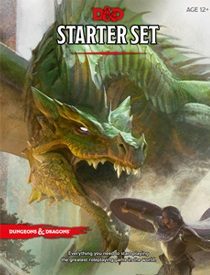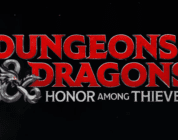Dungeons & Dragons has long been known as the fantasy themed role-playing game. Forty years after its original publication, Dungeons & Dragons has started the timed release of its fifth edition ruleset and first fifth edition adventure. The initial offerings from Wizards of the Coast include the Starter Set, the core rulebooks (Player’s Handbook, Monster Manual, and Dungeon Master’s Guide), and the Tyranny of Dragons adventure (split into two books: Hoard of the Dragon Queen and The Rise of Tiamat). This review will first address the system itself, which is what the overall score will be based on. The tail will be appended to include book-specific reviews as they are released.
We sat down to play, a motley crew of adventurers with vastly varying backgrounds in the game. The Dungeon Master (that would be me) who had never touched 4E, dabbled in 3/3.5E, and hadn’t played a real long-term campaign since 2.5E. The cleric who was introduced to the game through 3/3.5E. The human fighter who had never rolled a die. The dwarven fighter who primarily knew a modified version of 1/2. The halfling rogue who created the modified version of 1/2 and preferred that era, but had a working knowledge of all editions. We cracked open a copy of the Dungeons & Dragons 5th Edition Player’s Handbook, and started creating the characters we would use to traverse the cities and wilderness of Faerûn.
Almost immediately, it became obvious that this edition of Dungeons & Dragons was geared towards players more interested in roleplaying and less towards players more interested in playing a system; to a certain extent, at least, but that will be addressed later. The amount of XP required to level a character through the first few levels is drastically lower than what many returning players will expect, but it scales up significantly in higher levels. While the worlds of Dungeons & Dragons are dangerous, this new edition seeks to move away from the older editions’ tendencies to be overwhelmingly fatal for 1st level characters, and presents 1st level characters with an opportunity to develop a foundation of strength and capability early on before scaling into higher difficulties. This is not to say that a character can’t die, but that early success is rewarded more quickly in order to minimize the time spent rolling up a new character and maximize the time spent playing the game. Rocks may still fall, and everyone may die, but that’s the risk of living.
The classic races are represented (dwarf, human, halfling, and elf), with some of the extended races made immediately available as well (dragonborn, tiefling, half-elf, half-orc, and gnome). Most of the races provide further customization options that range from simple ethnicity choices that help direct appearance and history to detailed subraces that similarly help direct appearance and history as well as providing additional ability score and skill bonuses. For example, a human can choose the Chondathan ethnicity, described as “slender, tawny-skinned folk with brown hair…and green or brown eyes…dominating the central lands…around the Inner Sea.” There is no further ability bonus for choosing an ethnicity. A halfling, on the other hand, can choose to be either a Lightfoot or Stout subrace, which increases either your Charisma or Constitution, and provides either a stealth bonus or a resilience bonus, respectively.
The basic classes that a player of any edition or interest in fantasy should recognize return (fighter, rogue, and wizard) as well as many of the classes that were established as basic and extended classes in previous editions (barbarian, bard, cleric, druid, monk, paladin, ranger, sorcerer, and warlock). As with the races, many of the classes provide customization options at various levels. Clerics choose their domain of divinity at first level, which helps direct role/gameplay, and many classes can focus their direction at 3rd level with the choice of a class archetype. Fighters, for example, choose their martial archetype at 3rd level (Champion, Battle Master, or Eldritch Knight). Aside from the standard skills and abilities that a character class receives over the course of leveling, the archetypes (whether called one of the archetypes, clerical domains, bardic colleges, druidic circles, barbarian paths, monastic traditions, paladin oaths, or the various spellcasting sources) provides additional specific skills and abilities that help to define the character. Multiclassing is available for both role- and system-players, but it’s still coming later. There’s one element of character creation and customization left to cover: backgrounds.
There have been multiple options so far to customize your character and increase your starting abilities in a focused direction. The last character element of this is the background. Backgrounds allow you to flesh out your character’s past and can help provide players with a foundation for more rich storytelling and character development. There’s a versatile list of character backgrounds (acolyte, charlatan, criminal, entertainer, folk hero, guild artisan, hermit, noble, outlander, sage, sailor, soldier, and urchin), which each background being functional with every race/class combination. As with the races and classes, however, there is a certain synergy that can be taken advantage of for players who want to maximize starting abilities; choosing a race, class, and background that all provide bonuses to, and primarily function based off of, the same ability score/modifier can provide you with a stronger character. On the other hand, you have the flexibility to mix and match as you like, with no restrictions, allowing you to create characters that challenge your role-playing abilities and provide depth to the story.
Now, as promised, 5th Edition’s multiclassing rules. In certain past editions, the standard restriction placed on multiclassing was that your classes had to all remain within one level of each other. You could not go from a 4th level fighter/3rd level rogue (fighter 4/rogue 3) to a 5th level fighter/3rd level rogue (fighter 5/rogue 3); you would be required to increase your rogue level to equal your fighter level before being able to move your fighter level up again. This was to prevent players from simply taking the first level of many classes for the ability score bonuses and then never leveling those classes again. In 5E, the restriction on multiclassing levels is completely removed; you can level your characters completely as you please, with no XP penalty. As I mentioned earlier, the XP limits have been lowered in earlier levels. In past editions, XP requirements for leveling were class-specific, but in 5E it is a standard list for all classes. Your leveling is not based on either class level, but on your total character level. As a (fighter 5/rogue 3) you would be an 8th level character. There is, however, a balancing restriction placed on what elements of a 1st level multiclass that your character can use. You do not gain any ability score bonuses or equipment; you gain a limited set of class proficiencies and the standard class abilities. As you level that second, third, fourth, etc. class, you continue to gain all bonuses that class gains at higher levels. There is a ability score prerequisite for every class taken as a multiclass of 13, with the ability varying with the class.
Functionally, 5E has attempted to get out of the way as much as possible. It has done this with the introduction of two stellar elements: advantage/disadvantage and the proficiency bonus. Advantage/disadvantage does away (almost) entirely with the old system of determining a +/- value for rolls based on the difficulty of the attempt. No longer does a DM or player have to calculate the +/- for attacking uphill, flanking, etc. Now, an advantaged roll uses 2d20 and chooses the higher roll, while a disadvantaged roll uses 2d20 and chooses the lower roll. Advantage/disadvantage does not stack, so if you have an ability that grants you automatic advantage, and you are in a naturally advantageous position anyway, you do not roll an extra die. In this, I feel that the system is lacking, and will be implementing a personal house rule for extreme advantage/disadvantage, using 3d20. Moving on, the proficiency bonus is a standard + (ranging from 2-6) that gradually increases as a character levels up. This proficiency bonus is added to the base ability modifier for any skill, savings throw, weapon, or other roll that the character is specifically proficient in. This reduces much of the old math as well, and streamlines the entire + outside of ability score modifiers into a single value.
Leveling has become far more simple. I’ve covered the standard leveling table replacing class-specific leveling tables, as well as the speed with which the game takes you through the earlier levels. I’ve covered the concept of class bonuses that a character receives at certain levels. I’ve covered the proficiency bonus that increases with a character’s development and growth. But wait, there’s one last set of elements to cover: ability score improvements and feats. At five points in leveling for every class (4th, 8th, 12th, 16th, and 19th) but fighters and rogues (4th, 6th [fighter only], 8th, 10th [rogue only], 12th, 14th, 16th [fighter only], and 19th), a character can choose between receiving 2 ability points to distribute or forgoing that level’s ability points and taking a feat instead. The number of feats has been reduced, and they have been balanced for their role as an ability score improvement replacement. Perhaps a player with a fighter character wants the additional 2 points in Strength. Alternatively, the player can choose a feat like Heavy Armor Master, which provides the character with 1 point to Strength and a 3-point damage reduction from non-magical damage while wearing heavy armor. This choice depends entirely on the player and what the player thinks will be most beneficial to the character. (Note: I am still waiting on confirmation from WotC that the choice can be made with each opportunity to increase ability scores. The wording of the Feats section of the Player’s Handbook leaves room for interpretation that it is a character-permanent choice across all levels. WotC has confirmed that the game is balanced to have the choice available at each opportunity for ability score improvement.)
The 5th Edition of Dungeons & Dragons marks a return to the franchises roots, where the focus of the game was to tell a story. The streamlining of much of the game’s mathematics brings down the time it takes to complete combat by simplifying the process of figuring out attacks, bonuses, and damage. This streamlining allows the story to flow far more smoothly, giving both the Dungeon Master and the players a far more entertaining and immersive experience. There is still an opportunity for advanced customization, with the feats system, but Wizards of the Coast has made a step in the right direction. New players have a much lower learning curve to reach mastery, while seasoned players can take advantage of the system’s nuances to build a worthy adventurer.
Starter Set
The Starter Set is designed to serve as an introduction to the new system for players of all levels of experience, from novices unfamiliar with the satisfying roll of a d20 to veterans who have seen their past characters attain demigodhood.
The box is sturdy, and seems well manufactured. It’s a thick cardboard that won’t fall apart anytime soon. It is also well designed, and would not look out of place on a gaming shelf. Upon opening the box, you’re greeted with an attractive blue marble colored d20 dice set (1d20, 1d12, 1d10, 1d8, 1d6, and 1d4). Upon further inspection, you will find a starter set rulebook, an adventure book (The Lost Mine of Phandelver), and five pre-generated character sheets (a halfling rogue, a dwarven cleric, an elven wizard, and two human fighters). There’s not enough content to actually fill the box, so you do find a spacer fit to half of the box’s depth, but it was most likely cheaper to use a standard box size with a spacer than have a more fitted box manufactured. Regardless, it doesn’t take away from the presentation, and does provide you with a potentially nice storage box for character sheets and supplemental material if you choose to move deeper into the Dungeons & Dragons system beyond the starter set.
The included rulebook serves to frame the system in the context of the provided adventure. There is not enough information for independent character creation or advanced character elements (such as multiclassing), but it can directly answer questions that may arise within the boundaries of the Lost Mine of Phandelver adventure. It provides a great starting point for first-time Dungeon Masters to get a grasp of how to manage the game, but as with character creation and advanced elements, it does not provide enough content to functionally branch out beyond the adventure. Of course, it was not designed to do so. That’s what the Player’s Handbook and Dungeon Master’s Guide are for.
The Starter Set is available now for $19.99.
Player’s Handbook
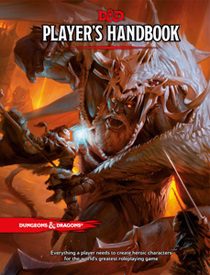 Character creation, customization, and advanced character elements are all presented in clear, reasonably organized detail within the tome’s 300+ pages, along with rules of play, a spectacular selection of spells, a comprehensive list of deities and pantheons for the more angelic/infernal minded player (and a description of the various planes of existence, along with a map showing relation), and over half a dozen pages dedicated to minor and common creature/monster stats. Approximately 100 of the book’s 300 pages are dedicated to character race, class, and background information, which helps to emphasize just how much value is placed by this system on roleplaying. An additional 80 pages are dedicated to the book’s list of spells and their effects.
Character creation, customization, and advanced character elements are all presented in clear, reasonably organized detail within the tome’s 300+ pages, along with rules of play, a spectacular selection of spells, a comprehensive list of deities and pantheons for the more angelic/infernal minded player (and a description of the various planes of existence, along with a map showing relation), and over half a dozen pages dedicated to minor and common creature/monster stats. Approximately 100 of the book’s 300 pages are dedicated to character race, class, and background information, which helps to emphasize just how much value is placed by this system on roleplaying. An additional 80 pages are dedicated to the book’s list of spells and their effects.
The book itself has a very strong, hefty feel to it. You could probably safely defend your home from intrusion by whacking someone on the head with it, is what I’m trying to say. Throughout the book’s glossy pages you will find absolutely beautiful art, depicting various people, creatures, locales, and more, ranging from small inserts to full page pieces. It is both well built and well designed.
It is not eminently helpful for crafting a custom campaign on its own, but paired with the Monster Manual, you technically have everything you need. The Dungeon Master’s Guide helps flesh out options for the Dungeon Master, and is definitely recommended (if not required) for those new to the art of gamerunning, but with the Player’s Handbook, the Monster Manual, and some creativity, you can take on the world.
The Player’s Handbook is available now for $49.95
Monster Manual
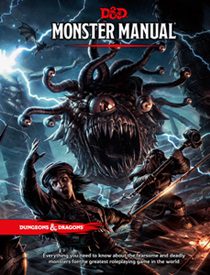 The Monster Manual, similarly to the Player’s Handbook, is beautifully built and designed. Almost every monster and creature has its own illustration, which makes the book not only an absolute treat to peruse, but also provides an excellent, and invaluable, visual reference for the Dungeon Master to use when describing the creatures and monsters his or her players encounter. As with the Player’s Handbook, the Monster Manual comes in at around 350 pages. Over 300 of those pages are solely dedicated to monsters of various alignments. An additional 30 pages are set aside for generic NPCs (non-player characters) and miscellaneous creatures and monsters that will be more common encounters, and can be easily modified for variety.
The Monster Manual, similarly to the Player’s Handbook, is beautifully built and designed. Almost every monster and creature has its own illustration, which makes the book not only an absolute treat to peruse, but also provides an excellent, and invaluable, visual reference for the Dungeon Master to use when describing the creatures and monsters his or her players encounter. As with the Player’s Handbook, the Monster Manual comes in at around 350 pages. Over 300 of those pages are solely dedicated to monsters of various alignments. An additional 30 pages are set aside for generic NPCs (non-player characters) and miscellaneous creatures and monsters that will be more common encounters, and can be easily modified for variety.
This book is vital to any Dungeon Master, whether operating a pre-generated campaign or a campaign painstakingly created by the Dungeon Master. Its value as a reference for the Dungeon Master while running a pre-generated campaign is immense, as it provides much more detail on creatures than the adventure books tend to, and gives the Dungeon Master some flexibility in modifying the adventure if/when the players choose to go off track. While creating a custom campaign, the book is absolutely invaluable. Your world can be as diversely populated as you could ever hope for, and you can set surprises for your players around every corner.
The Monster Manual is available now for $49.95.
Dungeon Master’s Guide
 The final book of the classic Dungeons & Dragons triumvirate of game books, the Dungeon Master’s Guide, has been released for the game’s 5th Edition. Similarly to the other books of this Edition, the Dungeon Master’s Guide sports a glossy hardcover and gorgeous illustrations throughout. As mentioned, the Player’s Handbook is the only book you really need to be able to play Dungeons & Dragons, so what’s the point of the Dungeon Master’s Guide? Who benefits from it?
The final book of the classic Dungeons & Dragons triumvirate of game books, the Dungeon Master’s Guide, has been released for the game’s 5th Edition. Similarly to the other books of this Edition, the Dungeon Master’s Guide sports a glossy hardcover and gorgeous illustrations throughout. As mentioned, the Player’s Handbook is the only book you really need to be able to play Dungeons & Dragons, so what’s the point of the Dungeon Master’s Guide? Who benefits from it?
Players don’t need it; only the titular Dungeon Masters will find practical purpose in the aptly named Dungeon Master’s Guide. To play a game, all you need is your imagination and a copy of the Player’s Handbook. If you’d like to jump into a pre-made story, you’ve got the Tyranny of Dragons storyline printed in the Hoard of the Dragon Queen and the Rise of Tiamat books. Let’s say you want to craft something epic, but want a little help in doing so? That’s where the Dungeon Master’s Guide comes in. The book walks you through creating a world of your own, as well as defining its place within the planes of a multiverse, if you want to get really intricate. It gives you tips on the core elements for crafting a story/adventure, filling your world with NPCs/villains/environments/treasure, linking your stories together to create a larger, persistent world for your adventurers to traverse, and more. It provides you with page upon page of randomization tables for encounters, NPC traits, effects, environment decoration, and more for game modification, population/item creation, and further customization of the world and the system. Did I mention the pages of detailed environment maps that you can copy and use in your stories? No? Well, I just did.
For new Dungeon Masters seeking to create a unique world of adventure, the Dungeon Master’s Guide is priceless (metaphorically, not literally – the book has an actual price, obviously). Veteran world builders looking for quick randomization tables have everything they need as well. It’s a solid book with a wealth of information.
The Dungeon Master’s Guide is available now for $49.95.
Hoard of the Dragon Queen
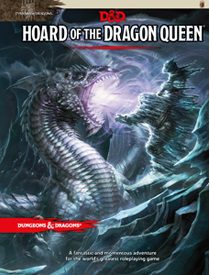 Hoard of the Dragon Queen is designed to introduce players to a dark and sinister plot that, if allowed to succeed, could shake the foundations of Faerûn. As a world-level adventure, the player characters encounter great risk and great reward, while encountering many of Faerûn’s well known protectors and defenders. From a DM’s perspective, the adventure is very well laid out, while still allowing for flexibility in how it unravels.
Hoard of the Dragon Queen is designed to introduce players to a dark and sinister plot that, if allowed to succeed, could shake the foundations of Faerûn. As a world-level adventure, the player characters encounter great risk and great reward, while encountering many of Faerûn’s well known protectors and defenders. From a DM’s perspective, the adventure is very well laid out, while still allowing for flexibility in how it unravels.
As with the core rulebooks, it is solidly built, and beautifully illustrated. All of the major encounterable NPCs and creatures are illustrated, and maps are provided for every relevant location. For new Dungeon Masters, the Hoard of the Dragon Queen does an excellent job of guiding you while you guide your players.
The Hoard of the Dragon Queen adventure suffers from one relatively minor, but noteworthy, problem. Namely, the book is incomplete. A great many of the specifically named monsters and creatures in the adventure are not to be found in either the Player’s Handbook monster list or in the Hoard of the Dragon Queen adventure monster list. Wizards of the Coast has released an online supplement (printer-friendly and printer-not-so-friendly-but-not-too-different-it’s-really-just-background-shading-that’s-different-but-this-is-getting-out-of-hand-so-back-to-the-sentence) that fills in all of the monster blanks, and provides a list of magical items and spells. The supplement is free, and was made available on the day of the adventure’s release, so as long as you have access either to a printer or a digital device, you should have a complete experience, but this is content that should have been part of the book itself in the first place.
The Hoard of the Dragon Queen adventure is designed to take characters from level 1 through approximately level 7, preparing them for the events of The Rise of Tiamat. The Hoard of the Dragon Queen is available now for $29.95.
The Rise of Tiamat
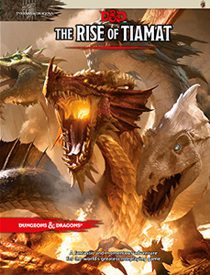 In the Hoard of the Dragon Queen, the foundation is set for world-shaking consequence. In The Rise of Tiamat, that promise is stunningly fulfilled. As with every previous book, The Rise of Tiamat is solidly bound and beautifully illustrated, with a logical flow. As with the Hoard of the Dragon Queen book, however, it is woefully incomplete, requiring one downloadable supplement to fill in creature and item statistics. There is a second supplement available, but as it is a diplomatic scorecard of sorts requiring marking, it isn’t something that should be in the book anyway.
In the Hoard of the Dragon Queen, the foundation is set for world-shaking consequence. In The Rise of Tiamat, that promise is stunningly fulfilled. As with every previous book, The Rise of Tiamat is solidly bound and beautifully illustrated, with a logical flow. As with the Hoard of the Dragon Queen book, however, it is woefully incomplete, requiring one downloadable supplement to fill in creature and item statistics. There is a second supplement available, but as it is a diplomatic scorecard of sorts requiring marking, it isn’t something that should be in the book anyway.
The Tyranny of Dragons campaign, across both books, is designed for a four-character party, with balancing required for larger or smaller parties. Aside from this, there is still room for the Dungeon Master to insert his or her own creative flair, though it should be approached with caution and consideration. I say this because The Rise of Tiamat becomes increasingly complex, especially nearer to the climax.
This adventure is, to put it simply, beautiful. Hinted at in Hoard of the Dragon Queen, the diplomacy, intrigue, and scale of The Rise of Tiamat is stunning, and makes both the players and the Dungeon Master feel immersed, invested, and influential in the events facing Faerûn. The climax of this adventure is, in their truest definitions, epic and awesome. First time Dungeon Masters and veteran world creators, first time players and players who have tasted godhood, all will find themselves ensorcelled by this strong first adventure for 5th Edition.
The Rise of Tiamat concludes The Tyranny of Dragons, begun in the Hoard of the Dragon Queen, and will bring characters up to approximately 15th level (or a gruesome, hilarious [for the DM] death). The Rise of Tiamat is available now for $29.95.

